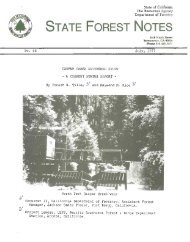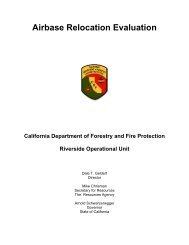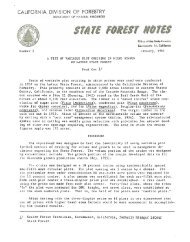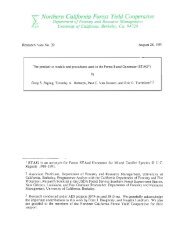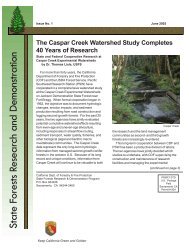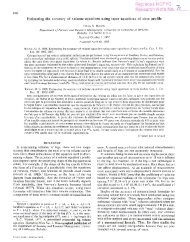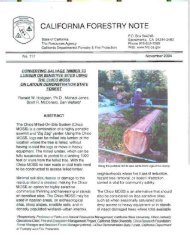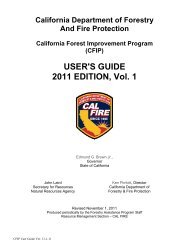The Plantation Cache Charmstone
The Plantation Cache Charmstone
The Plantation Cache Charmstone
You also want an ePaper? Increase the reach of your titles
YUMPU automatically turns print PDFs into web optimized ePapers that Google loves.
<strong>The</strong> <strong>Plantation</strong> <strong>Cache</strong><br />
and a<br />
New <strong>Charmstone</strong> Type from Northern California<br />
by:<br />
Susan M. Hector, Daniel G. Foster, Linda C. Pollack, and Gerrit L. Fenenga<br />
California Department of Forestry and Fire Protection<br />
September 20, 2006<br />
Note: This article was produced by the CDF Archaeology Program to inform its web audience of<br />
the discovery of a unique artifact type found in northern California and the results of our research<br />
to interpret its age, function, distribution, and archaeological significance. <strong>The</strong> specific locations<br />
of sites discussed in the text are not disclosed in conformance with state law.<br />
This is an expanded version of our original paper dated January 24, 2006 which we hope to<br />
submit for publication. This article has been created in HTML format for viewing on the CDF<br />
Archaeology Program website at: http://www.indiana.edu/~e472/cdf/plantation/index.htm . This<br />
version created in PDF format will enable readers to print a paginated copy of the article. Until<br />
such time as it might be published, the citation for this article should be:<br />
Hector, Susan M., Daniel G. Foster, Linda C. Pollack, and Gerrit L. Fenenga<br />
2006 <strong>The</strong> <strong>Plantation</strong> <strong>Cache</strong> and a New <strong>Charmstone</strong> Type from Northern California.<br />
Report on file at the California Department of Forestry and Fire Protection,<br />
Sacramento.<br />
Introduction<br />
This report describes an unusual assemblage of artifacts found in a pine tree plantation near<br />
Camptonville in Sierra County, California. <strong>The</strong> location of the discovery, the nature of the<br />
artifacts represented, and information from ethnographic sources all suggest the assemblage<br />
represents a cache of a shaman’s ritualistic paraphernalia. This find is particularly important in<br />
two respects. First, it represents the discovery of a specialized type of archaeological site that is<br />
rarely encountered, but important to understanding Native culture and land-use. <strong>The</strong> knowledge<br />
of such sites also is important to archaeologists who manage resources in locations where similar<br />
phenomenon might be encountered. Second, the cache contains what we believe to be a<br />
previously unrecognized form of charmstone that may have diagnostic spatial and temporal<br />
significance, as well as other important implications.<br />
<strong>The</strong> <strong>Plantation</strong> <strong>Cache</strong> was found in 1983 by Registered Professional Forester (RPF) Wendy<br />
Johnston while developing a pine tree plantation in Sierra County, California. Upon identifying<br />
the find, Johnston contacted Dan Foster, CDF Senior State Archaeologist, who then conducted a<br />
field visit and recorded the site. <strong>The</strong> unusually large bipointed oval charmstone stood out and<br />
came to be referred to as the “football”, an unfortunate identifier, but one that has subsequently<br />
stuck. Since the discovery of the <strong>Plantation</strong> <strong>Cache</strong> artifacts, several additional examples of the
<strong>The</strong> <strong>Plantation</strong> <strong>Cache</strong> and a New <strong>Charmstone</strong> Type from Northern California<br />
Hector, Foster, Pollack, and Fenenga<br />
associated “football” type charmstone have been identified. Until recently, this particular form<br />
appears to have been missed or overlooked, although there are over 100 years of published<br />
research on California charmstones (for a review of charmstone typologies and discussion of<br />
another CDF discovery, see Hector et al. 2005). <strong>The</strong> football type charmstone is similar in<br />
appearance to the more common “lemon” type found in northern California, but it is much larger<br />
and of different material than are most lemon-shaped stones. Foster and Johnston’s (1983)<br />
description of the large, football-shaped charmstones with blunt or tapered ends was included in<br />
the Elsasser and Rhode study of charmstone types (1996:16), but provisionally placed into their<br />
catch-all “unique” category (Type U). <strong>The</strong>y suggested additional research on these may be<br />
warranted with “further finds” that might clarify their status. This paper provides an opportunity<br />
to call further attention to these unusual artifacts and to formally add the type to the<br />
archaeological record.<br />
Discovery and Context of the <strong>Cache</strong><br />
Susan Hector recently interviewed Wendy Johnston, now with Vestra Resources in Redding,<br />
California, about her 1983 discovery. During the summer of 1982, Johnston was working on a<br />
progeny test site on a hilltop near Camptonville, at an elevation of 3,400 feet in Sierra County,<br />
California. <strong>The</strong> location had burned in the past, and had been logged, leaving few trees<br />
remaining on the slope. Originally, the hill had been covered with black oaks. <strong>The</strong> slope was<br />
prepared for planting by ripping the soils to a depth of 18", and all vegetation was removed.<br />
Small pine trees were planted. In the spring of 1983, Johnston revisited the location to check on<br />
the trees.<br />
A sparkling white object caught her eye--the<br />
quartz, football-shaped charmstone. Nearby<br />
lay an elongated mano and a potato-shaped<br />
rock. Figure 1 is a photograph taken of the<br />
discovery in 1983, with Johnston kneeling<br />
near the artifacts. All three objects were<br />
covered with orange clay, and must have been<br />
buried below the ground surface. She<br />
carefully inspected the discovery site, but<br />
observed no additional artifacts, rocks, or<br />
anything else unusual. Johnston knew Foster,<br />
and had spoken to him many times about<br />
archaeology and forestry, so she contacted<br />
him to come see the location and artifacts.<br />
Foster visited the site in August 1983 and<br />
observed that there was no evidence of any<br />
archaeological midden deposit, nor any other<br />
Figure 1. Registered Professional Forester Wendy Johnston<br />
at the discovery location for the <strong>Plantation</strong> <strong>Cache</strong> artifacts,<br />
CA-SIE-378, in 1983. (Photo by Dan Foster)<br />
artifacts located in proximity to the finds. This location is devoid of field stone, and the three<br />
specimens that Wendy found stood out as foreign to the surroundings.<br />
2
<strong>The</strong> <strong>Plantation</strong> <strong>Cache</strong> and a New <strong>Charmstone</strong> Type from Northern California<br />
Hector, Foster, Pollack, and Fenenga<br />
<strong>The</strong> <strong>Plantation</strong> <strong>Cache</strong> was found within the ethnographic territory of the northern Nisenan<br />
(Kroeber 1925: Plate 37, Map showing Territory and Villages of the Maidu and Miwok). An<br />
archaeological village site with midden, artifacts, and milling, recorded as CA-SIE-7, is located<br />
approximately ¼ mile from the discovery. CA-SIE-7 is a large, multicomponent habitation site<br />
located in a meadow (Wheeler and Stevens 1980). Four basalt points were observed at the site.<br />
Nearby, CA-SIE-337 was recorded as a lithic artifact scatter possibly associated with CA-SIE-7;<br />
basalt projectile points were also found at that site (Stevens et al. 1980).<br />
Foster realized that the three artifacts discovered by Wendy Johnston may represent a cache,<br />
perhaps a group of objects used by a shaman and either deposited in an oak tree or buried. He<br />
proposed that the shaman may have been visiting or affiliated with the village recorded as CA-<br />
SIE-7. No one who observed the discovery saw any evidence that the artifacts were buried in any<br />
recognizable pit or other feature. <strong>The</strong>y do appear to have buried at the time they were disturbed<br />
by site preparation for planting, although this might have simply occurred through natural<br />
processes. <strong>The</strong> <strong>Plantation</strong> <strong>Cache</strong> was recorded as CA-SIE-378.<br />
Contents of the <strong>Plantation</strong> <strong>Cache</strong>: Description of the Artifacts<br />
<strong>The</strong> <strong>Plantation</strong> <strong>Cache</strong> contained only three known artifacts. It is, however, quite possible that<br />
these objects were once included with other perishable materials that did not survive the<br />
elements. For this area, Kroeber (1925: 426) states: “<strong>The</strong> shaman’s paraphernalia are not<br />
destroyed at his death among the northeastern Maidu, but are carefully preserved for his children.<br />
Should they be too young at the time, their mother or some other relative maintains the<br />
knowledge of their hiding place. <strong>The</strong>se paraphernalia include certain objects called yompa (hill<br />
dialect yomepa) which apparently are made by the shaman out of feathers and other objects.”<br />
Ethnographic and archaeological examples of shaman’s bundles from elsewhere in California<br />
invariably contain a variety of animal and vegetable materials, as well as mineralogical<br />
specimens including pigments, crystals, fossils, and oddly-shaped rocks.<br />
<strong>The</strong>re are other instances where a reported “shaman’s cache” contained as few as three objects<br />
(Langenwalter 1980), although others have included considerably more, such as the cached<br />
assemblage of eighty ritual objects described by Wallace from Pacific Palisades (1987: 47-58) or<br />
the remarkable collection found stashed in Bowers Cave (Elsasser and Heizer 1963).<br />
Noteworthy in the <strong>Plantation</strong> <strong>Cache</strong> are the presence of grinding implements, essential tools in<br />
the outfits of curing doctors who made extensive use of herbal medicine.<br />
<strong>The</strong> individual artifacts associated with the <strong>Plantation</strong> <strong>Cache</strong> are described below:<br />
Football-shaped <strong>Charmstone</strong> (Figures 2, 3, and 4)<br />
This football-shaped artifact is made of white quartz that was extensively shaped by pecking and<br />
was then heavily ground and polished. Polishing striations are numerous, distinctive (in the<br />
correct lighting), and perpendicular to the long axis. Both ends are ground flat, but one end<br />
shows signs of battering and some small spalling scars. <strong>The</strong> object measures 184 x 74 x 68 mm,<br />
and weighs 1303.2 g. <strong>The</strong> artifact has been stained with reddish-brown material that may<br />
3
<strong>The</strong> <strong>Plantation</strong> <strong>Cache</strong> and a New <strong>Charmstone</strong> Type from Northern California<br />
Hector, Foster, Pollack, and Fenenga<br />
represent intentional coloring with ochre, natural discoloration from the surrounding soil, or a<br />
combination of these (see Figure 3).<br />
Figure 2. <strong>The</strong> <strong>Plantation</strong> <strong>Cache</strong> Quartz <strong>Charmstone</strong>. (Photo by ASM)<br />
<strong>The</strong> polished surface on the exterior of this artifact indicates it is a complete, finished object. It<br />
is not perforated, nor is there any evidence there ever was any attempt to do so. Given its<br />
biconical symmetry and lack of perforation, it does not appear to have been designed for<br />
suspension. Similar “cigar-shaped” charmstones<br />
from the Santa Barbara Channel were attached<br />
around the middle and suspended horizontally<br />
(King 1990: 265, Figure 33). In this respect,<br />
they are reminiscent of bone gorges used for line<br />
fishing in that region, and they may have been<br />
symbolic of that activity. Many of those<br />
charmstones still retain traces of asphaltum,<br />
sometimes with string impressions still present.<br />
<strong>The</strong> <strong>Plantation</strong> specimen bears no evidence of<br />
any adhesive, or any other obvious reason to<br />
believe that it was ever suspended.<br />
<strong>The</strong> flat, squared-off ends (see Figure 4) of the<br />
<strong>Plantation</strong> charmstone may be significant. <strong>The</strong>se<br />
are unlike the pointed, incurved ends of the<br />
Figure 3. <strong>The</strong> <strong>Plantation</strong> <strong>Charmstone</strong> in Dan Foster’s hand<br />
showing size and red stains on artifact. (Photo by Linda<br />
Pollack)<br />
lemon-shaped charmstones or of other football-shaped ones (see example from CA-SHA-1760/H<br />
described below). <strong>The</strong> ends of the <strong>Plantation</strong> specimen, and others like it, resemble the ends of<br />
pestles used in stone mortars. Medicine pestles were used by Native doctors and perhaps these<br />
somehow functioned in this way.<br />
4
<strong>The</strong> <strong>Plantation</strong> <strong>Cache</strong> and a New <strong>Charmstone</strong> Type from Northern California<br />
Hector, Foster, Pollack, and Fenenga<br />
<strong>The</strong> <strong>Plantation</strong> charmstone was manufactured of brilliant white<br />
opaque quartz. This would be an extremely hard material to<br />
grind and polish (Hardness of 7+ on Mohs scale). Quartz is<br />
known to have piezoelectric properties, which makes it glow<br />
when rubbed against another stone and create sparks when<br />
struck. Quartz pebbles are identified in the southwest as<br />
“thunder and lightning” stones due to this property and were<br />
used in ceremonies by priests. <strong>The</strong>se qualities may also have<br />
been realized with the <strong>Plantation</strong> charmstone, resulting in the<br />
polished surface and possible use-wear on its ends.<br />
<strong>The</strong> absence of a perforation may be related to the hardness of<br />
the material, but more likely to style. In central California,<br />
perforated charmstones generally precede unperforated ones,<br />
and the perforated charmstones are usually made of harder<br />
Figure 4. Drawing of the <strong>Plantation</strong><br />
<strong>Charmstone</strong> by B.J. Ciccio showing<br />
profile at cross section and blunted<br />
ends.<br />
stone materials. <strong>The</strong> <strong>Plantation</strong> specimen, like other football type charmstones, remains to be<br />
dated in any meaningful way. How this style fits into this trend remains to be determined.<br />
As discussed elsewhere in this paper, the author’s believe this football-shaped charmstone is<br />
representative of a distinct form that is formal type of charmstone. Following Ragir (1972), the<br />
<strong>Plantation</strong> artifact is the Type Specimen for the Football Type. Based on analysis of a variety of<br />
charmstone data, this type can be discriminated upon the basis of shape, size, material, and<br />
geographic distribution.<br />
Potato-shaped Artifact (Figure 5)<br />
This artifact has been referred to as potato-shaped but could also be seen as having the shape of<br />
an animal, a tumor, or almost anything you could imagine. If it were not associated with the<br />
other two artifacts in the cache, there is<br />
nothing about it that suggests it represents a<br />
cultural artifact. Natural stones with unusual<br />
shape or color were often collected by native<br />
people and imbued with special meaning and<br />
qualities. In the American Southwest, these<br />
are called fetishes. A natural rock may appear<br />
to the collector in the shape of a totem animal<br />
or dream messenger. In the right light, the<br />
potato-shaped stone can be seen to have the<br />
shape of a bear. In California, special stones<br />
were sometimes heated and used in healing<br />
practices. Polished, but otherwise unmodified<br />
stones in known curing outfits have been<br />
attributed to this function.<br />
Figure 5. <strong>The</strong> <strong>Plantation</strong> <strong>Cache</strong> Unmodified, Potato-shaped<br />
Stone. (Photo by ASM)<br />
5
<strong>The</strong> <strong>Plantation</strong> <strong>Cache</strong> and a New <strong>Charmstone</strong> Type from Northern California<br />
Hector, Foster, Pollack, and Fenenga<br />
<strong>The</strong> banded material of which it is composed appears<br />
to be some type of sedimentary stone. <strong>The</strong> banding<br />
appears to be more resistant to wear. Some areas of the<br />
artifact appear to be polished, but on closer<br />
examination this polishing seems to be natural since<br />
both high and low points are equally smooth. <strong>The</strong><br />
artifact measures 126 x 81 x 65 mm, and weighs 908.3<br />
g. While itself a red-brown color, the stone also bears<br />
a reddish stain like the other two artifacts in the cache.<br />
Two-handed Mano/Pestle (Figure 6 and 7)<br />
This elongated hand stone is made of vesicular basalt<br />
or basalt-like stone. It is well-shaped on all aspects,<br />
but only two edges were flattened from use. <strong>The</strong><br />
object measures 200 x 71 x 57 mm, and weighs 1209.6<br />
g. <strong>The</strong> pores or vesicles of the stone contain reddish<br />
material that may be ochre or the natural surrounding<br />
iron-rich soil matrix. Milling tools for grinding<br />
pigments occur in known shaman’s kits (Kelly 1978:<br />
420, Figure 5), and this implement might have seen<br />
use for this purpose.<br />
Artifacts similar to this are known from northeastern<br />
California, where they usually served as a combination<br />
two-handed mano and pestle (Miles 1963:45; Figure<br />
1.239).<br />
Discussion<br />
<strong>The</strong> <strong>Plantation</strong> <strong>Cache</strong> is an important discovery and<br />
warrants some discussion in terms of both the subject<br />
of the cache and its implications, as well as the issue<br />
of the football charmstone and the merits of assigning<br />
it formal typological status. Each of these topics will<br />
be reviewed.<br />
Interpretation of the <strong>Cache</strong><br />
Francis (Fritz) Riddell, former State Archaeologist and<br />
retired supervisor of the California State Parks<br />
archaeology program, was extremely interested in the<br />
<strong>Plantation</strong> <strong>Cache</strong> artifacts, having worked with them<br />
Figure 6. <strong>The</strong> <strong>Plantation</strong> <strong>Cache</strong> Two-handed<br />
Mano/Pestle. (Photo by ASM)<br />
Figure 7. Drawing of the <strong>Plantation</strong> <strong>Cache</strong> Twohanded<br />
Mano/Pestle by B.J. Ciccio. Note the<br />
pronounced shouldering.<br />
in the CDF training collection for several years. Like Foster, Riddell proposed the idea that the<br />
artifacts might represent a buried, disturbed cache. More specifically, he theorized that the black<br />
oaks that were growing on the hillside before it was cleared had hollows that could have been<br />
6
<strong>The</strong> <strong>Plantation</strong> <strong>Cache</strong> and a New <strong>Charmstone</strong> Type from Northern California<br />
Hector, Foster, Pollack, and Fenenga<br />
used by shamans to cache their powerful ceremonial objects. Power items are often stashed<br />
away and hidden from others who do not have the knowledge of their use. A curing shaman<br />
would only bring these objects out at certain times. Riddell’s proposition would explain why<br />
these ceremonial objects were found on a hill and not in the nearby village.<br />
Riddell’s theory has its basis in the ethnographic literature of the area. <strong>The</strong> Yana collected small<br />
round stones that had unique color, marks, or shape to cure disease, bring hunting luck, and<br />
bestow other benefits to the owner (Sapir 1908). <strong>The</strong> territory of the Yana, located east of the<br />
Sacramento River between Pit River and Rock Creek, is situated in the vicinity of the <strong>Plantation</strong><br />
<strong>Cache</strong> site and the other sites discussed in this article (Johnson 1978: 361). <strong>The</strong> following<br />
information on Yana “luck-stones” is from Sapir (1908) and may be relevant to interpreting the<br />
<strong>Plantation</strong> <strong>Cache</strong>:<br />
<strong>The</strong>y were believed to bestow good luck upon their finder and possessor in whatever<br />
pursuit he required their aid.... As a rule, the possession of these luck-stones was kept a<br />
secret, as indicated, for instance, by the fact that they were not kept in the house, but in<br />
some secluded spot in the woods known only to their possessor.... <strong>The</strong> spruce basket, with<br />
its luck-stones, was not placed on the ground, but was hidden up in a tree, so that no one<br />
might touch it.<br />
<strong>The</strong> most potent of the luck-stones were “small, white prismatic rocks, generally of quartz,” and<br />
referred to by his informants as “diamonds” (Sapir 1908). Quartz has a special quality that was<br />
recognized by native people. Whitley et al. (1999) described the belief that fracturing quartz<br />
releases power; this is largely due to the fact that quartz and quartzite are piezoelectric. Both<br />
rocks produce a luminescent glow when struck, but more so with quartz. Quartz crystals, for<br />
example, were prized for this reason. In recognition of the physical properties of quartz, Native<br />
Americans used quartz extensively for religious and ritual items (Whitley et al. 1999: 10).<br />
Kroeber (1925: 426) is quoted above in regard to the dispensation of shaman’s paraphernalia<br />
among the Nisenan, and his remarks undoubtedly apply to neighboring tribes. <strong>The</strong> fact that<br />
certain tribes passed on shamanistic paraphernalia, while others destroyed it at the shaman’s<br />
death is significant. This comment has implications for explaining the isolated occurrence of the<br />
<strong>Plantation</strong> <strong>Cache</strong> and why its contents may never have ended up “destroyed” in a cemetery.<br />
Observations like this may be helpful in sorting out ritual practices and cultural boundaries and<br />
through time using charmstone data.<br />
Broadly speaking, throughout northern California there was a distinction between curing<br />
shaman, or doctors proper, and dreaming or clairvoyant shaman (Kroeber 1925: 423-424). <strong>The</strong>re<br />
also were special classes of shaman. For the Maiduan groups, Kroeber (1925: 427) lists rain<br />
doctors, or weather shamans, rattlesnake doctors, and grizzly bear shamans. He believed the<br />
Maidu were at the northern limits for rain doctors due to the environment, suggesting this class<br />
was not particularly important (Kroeber 1925).<br />
Among the Wintu, charmstones were primarily hunting amulets (Kroeber 1925:361). <strong>The</strong><br />
McCloud Wintu kept lucky stones outside the house, because if having intercourse in the house,<br />
such a stone might make the possessor sick or blind (Voegelin 1942: 202). <strong>The</strong>se lucky stones<br />
7
<strong>The</strong> <strong>Plantation</strong> <strong>Cache</strong> and a New <strong>Charmstone</strong> Type from Northern California<br />
Hector, Foster, Pollack, and Fenenga<br />
were passed on at death. A Valley Maidu (Konkow) informant from near Chico told Erminie<br />
Voegelin (1942) that charmstones were “kept in an old oak tree by a person who knows how to<br />
take care of them.”<br />
For the Shasta, Holt (1946:326-336) provides one of the most detailed descriptions of religious<br />
conceptions and shamanism known from California ethnology. Her data came from interviews<br />
with Dixon’s (1907) principal informant Sargent Sambo, a hereditary chief of the Klamath River<br />
Shasta (Holt 1946: 299). Sargent was also a shaman, as was his paternal grandmother and four<br />
paternal aunts (Holt 1946: 328). Among the Shasta, shamans were chiefly women, with males<br />
thought “less proficient” in this profession (Holt 1946: 327). Shamans were persons of great<br />
importance to the tribe “and in them and their ceremonials almost the whole ritual of the people<br />
is included (Holt 1946: 238, citing Dixon 1907: 471).” <strong>The</strong>y were not popular, however, as “a<br />
doctor is no friend to anybody except her own family (Holt 1946: 328).” A shaman could not<br />
take part in any dance, except the puberty, took no active role in any funeral, and did not gamble<br />
(Holt 1946: 328). <strong>The</strong> position of shaman was usually hereditary, with a shaman selecting one of<br />
her own children, or those of a brother or sister (Holt 1946: 328). Shasta shaman received their<br />
power from the “axaiki”, mysterious spiritual powers that inhabited all of Shasta territory (Holt<br />
1946: 326). <strong>The</strong>y were conceived as of a human form and inhabited rocks, cliffs, lakes, rapids,<br />
mountain summits, and eddies and rapids in streams (Holt 1946: 326). Many animals were also<br />
regarded as axaiki, who were the cause of all disease, death, and trouble. <strong>The</strong>y became the<br />
guardians of shamans and were often inherited by them (Holt 1946: 326).<br />
A Shasta shaman’s child could not become a shaman during her lifetime according to Dixon<br />
(1907: 471), but could according to Holt (1946: 328), provided they did not use the same axaiki.<br />
<strong>The</strong>n, at the mother’s death, the daughter took over her paraphernalia and received her axaiki, or<br />
if the daughter was not yet a shaman, the axaiki would come to her later when she was (Holt<br />
1946: 328). A shaman had an assistant to care for her paraphernalia, a woman relative.<br />
Sargent’s assistant was his mother (Holt 1946: 328). Holt’s (1946: 328) description of the<br />
curation of the shaman’s outfit relates directly to the <strong>Plantation</strong> <strong>Cache</strong> discovery.<br />
When not in use, the paraphernalia were hidden in the woods. <strong>The</strong>y received no<br />
special attention other than being carefully wrapped and placed in a tree, under<br />
which red paint was kept in ten spots on a board. <strong>The</strong> paraphernalia must be<br />
away from the odor of burning, or the shaman would die. Nothing a shaman used<br />
in her professional capacity must be underground. Upon her death her<br />
paraphernalia were hung away on a tree where they would be blown away or<br />
naturally destroyed. For a year or more after a shaman’s death, her assistant daily<br />
put out paint for her different axaiki, telling them she was putting out this paint<br />
for them and asking them to care for the children. Sometimes she also put out<br />
other things, such as feathers, in the nature of small offerings to them.<br />
<strong>The</strong> ethnographic record of northeastern California, in spite of inherent weaknesses, provides a<br />
coherent basis for explaining the <strong>Plantation</strong> <strong>Cache</strong>. <strong>The</strong>re are sufficient examples and<br />
explanations for the caching of powerful and potentially dangerous ritual paraphernalia to infer<br />
the <strong>Plantation</strong> <strong>Cache</strong> is an archaeological example of such a site. <strong>The</strong> contents of the cache<br />
suggest the property of a curing shaman, as grinding implements imply the preparation of herbal<br />
8
<strong>The</strong> <strong>Plantation</strong> <strong>Cache</strong> and a New <strong>Charmstone</strong> Type from Northern California<br />
Hector, Foster, Pollack, and Fenenga<br />
medicine. It is noteworthy that grinding implements were associated with a Coast Miwok<br />
curing/poisoning shaman’s kit (Kelly 1978: 420-421), but absent from a Tubatulabal weather<br />
shaman’s fetish bundle (Fenenga and Riddell 1978; n. d.).<br />
It is possible that the <strong>Plantation</strong> <strong>Cache</strong> represents a votive offering, a shrine, or some other kind<br />
of specialized functional location. Ethnographic descriptions of other kinds of ritual sites in this<br />
region, however, do not conform as clearly to the <strong>Plantation</strong> discovery as do the shaman’s cache<br />
descriptions.<br />
Justification for a New Formal <strong>Charmstone</strong> Type<br />
In 1936, Alfred Kroeber published a landmark survey of the status of California prehistory and<br />
concluded “California prehistory has long been resistive to interpretation and promises to remain<br />
so (1936:115).” Seventy years later, this statement holds true, in part perhaps because few<br />
researchers chose to heed his advice elsewhere in that same paper. Here, after reviewing<br />
evidence and possible approaches to sorting out cultural chronology, he had stated “Our one thin<br />
guiding thread backward into the prehistory of most of California is… the much-debated<br />
plummet-shaped stone which the historic Indians did not make but did use as a charm.” He went<br />
on to add, “Other artifacts may ultimately prove to be even more useful; but it does seem as if the<br />
charmstone, treated by the strict Nordenskiold method, or analogously to the potsherd in pottery<br />
areas, will definitely help us to arrive at interpretations on cultural sequences (Kroeber 1936:<br />
114).” Kroeber realized that the study of these artifacts in terms of their relative frequencies,<br />
possible changes in form, and so on, would require systematic classification and he was<br />
encouraging California archaeologists to pursue this. This paper is an attempt to follow his<br />
advice by presenting evidence that we believe substantiates the idea that the American footballshaped<br />
charmstones we have described here constitute a formal regional type. <strong>The</strong> existence of<br />
this specialized type of charmstone presents implications that bear on Kroeber’s concerns, as<br />
well as issues of relevance to more modern anthropologists.<br />
Initially, Foster believed the <strong>Plantation</strong> <strong>Cache</strong> charmstone to be unique, but in the years after its<br />
discovery, a few other nearly identical objects came to his attention. All of them shared the<br />
following characteristics:<br />
• <strong>The</strong>y were made of high-quality white quartz.<br />
• <strong>The</strong>y all were relatively large -- approximately 20 cm long and 8 cm wide.<br />
• <strong>The</strong>y were all football shaped, although some had tapered ends and others had blunt ends.<br />
• All were found in the northern Sacramento Valley or adjacent foothills.<br />
Impressed with this group of artifacts, Foster paraded the <strong>Plantation</strong> <strong>Cache</strong> contents around the<br />
state, including the Annual Meetings of the Society for California Archaeology, and showed<br />
them to as many of his colleagues as he could. Among those he consulted were Albert Elsasser<br />
and Peter Rhode who were in the process of revisiting the issue of California charmstones and<br />
preparing a typological study (Elsasser and Rhode 1996). Dr. Elsasser provided the following<br />
suggestions regarding the classification of the football charmstone type in a letter sent to Dan<br />
Foster:<br />
9
<strong>The</strong> <strong>Plantation</strong> <strong>Cache</strong> and a New <strong>Charmstone</strong> Type from Northern California<br />
Hector, Foster, Pollack, and Fenenga<br />
Dear Dan: Thanks so much for sending along the information on the Northern<br />
California charmstone. It is indeed a new type, so far as I can see, though I think the<br />
closest we can come is to include it as a rare variant of the smaller lemon-shaped<br />
example of the north. I’m afraid that we cannot do it full justice in a large article, and<br />
therefore suggest that you go ahead and publish it, and designate it as an oval-shaped<br />
form with blunt ends … (Elsasser 1991).<br />
To incorporate the football type into the charmstone typology developed by Elsasser and Rhode<br />
would require either grouping them with their ovoid shape Type O or symmetrical spindle shape<br />
Type S, or instead lumping them together with cogstones, propellers, and objects from outside of<br />
California do not seem to us to have merit. Doing any of these would only serve to obfuscate<br />
their significance, which is embodied in their recognition as an artifact class.<br />
We believe the football-shaped charmstones constitute a distinct class, or type. <strong>The</strong> type is<br />
characterized by:<br />
1) A bipointed oval outline morphology that is reminiscent of the shape of an<br />
American football. <strong>The</strong> ends may be either pointed or blunted (these traits<br />
identify possible subtypes). Cross-sections vary from round to flattened oval<br />
shape. Curvature of the outline margins is rounded and not angled at<br />
midsection (as are Ragir’s Type B3). Length to width ratio for the Type<br />
Specimen is 2.49; the range for the type is 1.97 to 2.49.<br />
2) Relatively large size. Type specimen is 184mm in length; range for type is<br />
160-193mm. Widths vary due to variation in cross-section. Type Specimen<br />
measures 68 to 74mm in width; range for type is 68mm to 80mm in width.<br />
3) Manufactured usually of high-grade quartz or quartzite; sometimes of other<br />
hard stone.<br />
4) Distribution in the northern Sacramento Valley and adjacent foothills. Type<br />
Specimen is from historic Maidu (Nisenan) territory; others from Konkow,<br />
Yana, Shasta, and Wintu territories.<br />
Each of these criterion merit substantiation. Some comments will help justify our position.<br />
<strong>Charmstone</strong>s are not particularly common in the northern Sacramento Valley, or in adjacent<br />
regions to the east or north. Large collections usually contain only a few esoteric artifacts<br />
relative to large numbers of projectile points, milling equipment, and other utilitarian<br />
implements. In contrast, charmstones and other oddities dominate large archaeological<br />
collections from the San Francisco Bay, the Sacramento-San Joaquin Delta, and the San Joaquin<br />
Valley. <strong>The</strong> football-shaped charmstone form is presently distinct, in part, because of its<br />
distribution in an area where charmstones are virtually unknown, either archaeologically or<br />
ethnographically.<br />
Football charmstones are further distinct in their absence from the San Francisco Bay Region,<br />
the North Coast Region, and the Sacramento-San Joaquin Delta Region. <strong>The</strong>se are areas where<br />
large numbers of charmstones have been recovered and collections relatively intensively studied.<br />
This absence explains why the type has been overlooked by past researchers. Heizer (1949:<br />
10
<strong>The</strong> <strong>Plantation</strong> <strong>Cache</strong> and a New <strong>Charmstone</strong> Type from Northern California<br />
Hector, Foster, Pollack, and Fenenga<br />
Figure 8f) illustrates an unperforated Type B3 “diamond” shape charmstone that looks very<br />
similar to the football specimens. He also presents a photograph of a burial from CA-SAC-107<br />
that shows one or more similar charmstones (Heizer 1949: Plate 3d). This photo was duplicated<br />
in Moratto (1984: 204, Figure 5.13) to show a “typical” Windmiller charmstone grave<br />
association. It is very unusual for Windmiller charmstones to not be perforated, so these are not<br />
“typical”. For comparative purposes, we present a close up view of this photo (Figure 8), and an<br />
illustration (Figure 9, item f), from Heizer’s (1949: Figure 8) typology that shows an example of<br />
one of the CA-SAC-107 specimens.<br />
<strong>The</strong> 1935 photograph of a Windmiller Pattern burial from CA-SAC-107 (Moratto 1984:204,<br />
Figure 5.13) reveals at least six charmstones in association, and two of these do indeed look like<br />
they could be additional examples of the new charmstone type discussed in this paper. <strong>The</strong>y<br />
appear to be quite large, unperforated, football-shaped with blunted ends, and possibly made<br />
from bright white stone – perhaps quartz (Figure 8). To investigate this further, the authors<br />
contacted Natasha Johnson of the Phoebe Hearst Museum of Anthropology to inquire if those<br />
two charmstones could be located in the collections housed at the museum. <strong>The</strong>re are 93<br />
charmstones in the collections from CA-SAC-107 but unfortunately, the two depicted in that<br />
photograph could not be immediately located, so we were unable to confirm or refute the<br />
possibility that additional examples of this new type were recovered at the Windmiller Site.<br />
←<br />
←<br />
Figure 8. Possible football charmstones from<br />
1935 excavations at CA-SAC-107. (Photo modified<br />
by ASM from photo in Moratto 1984:204, Figure 5.13)<br />
Natasha Johnson reviewed the collection of 93<br />
charmstones from CA-SAC-107, then sent us<br />
information on approximately 8 specimens<br />
which somewhat resemble our proposed new<br />
charmstone type. She graciously provided<br />
Figure 9. Illustration of an imperforate bipointed Type B<br />
charmstone from CA-SAC-107.(From Heizer 1949: Figure<br />
8f)<br />
photographs, catalogue numbers, and descriptions. Most of these were either too small, were<br />
perforated, or simply didn’t match the morphological bipointed oval outline closely enough and<br />
were excluded. Two of these, for example (Figures 10 and 11) were similar in shape but too<br />
11
<strong>The</strong> <strong>Plantation</strong> <strong>Cache</strong> and a New <strong>Charmstone</strong> Type from Northern California<br />
Hector, Foster, Pollack, and Fenenga<br />
small in length, 75 and 98 mm respectively. <strong>The</strong>y both appear to be a good fit for Sonia Ragir’s<br />
(1968) Type B3 discussed below. Two additional charmstones from CA-SAC-107 (Figures 12<br />
and 13) are also similar but too small and are perforated with a biconically-drilled hole at one<br />
end.<br />
Figure 10. <strong>Charmstone</strong> from SAC-107 recovered in 1937.<br />
Catalogue number 1-46186. (<strong>The</strong> Hearst Museum of<br />
Anthropology, photo courtesy Natasha Johnson)<br />
Figure 12. Bipointed, Perforated <strong>Charmstone</strong> from SAC-107.<br />
Catalogue number 1-46462. (<strong>The</strong> Hearst Museum of<br />
Anthropology, photo courtesy Natasha Johnson)<br />
Figure 11. Good example of Type Diamond Shaped Type B3<br />
described by Sonia Ragir. Catalogue number 1-46283.<br />
(<strong>The</strong> Hearst Museum of Anthropology, photo courtesy Natasha<br />
Johnson)<br />
Figure 13. Bipointed, Perforated <strong>Charmstone</strong> from SAC-107.<br />
Catalogue number 1-46222. (<strong>The</strong> Hearst Museum of<br />
Anthropology, photo courtesy Natasha Johnson)<br />
Sonia Ragir reanalyzed the Windmiller materials and in her revision of the charmstone typology<br />
noted that the Type Specimen (LM-16280) for the diamond shape Type B3 charmstone is<br />
unperforated and “probably unfinished”(Ragir 1968:169). She notes that two of ten others from<br />
CA-SAC-107 have “incipient perforations”. Type B3 charmstones are somewhat similar in form<br />
to football charmstones, including having their “tips and ends flattened” (Ragir 1968:169).<br />
However, Ragir indicates they are “always short” ranging from 65-118mm in length with a<br />
“marked angularity” at midpoint (Ragir 1968:169). Furthermore, very few Windmiller<br />
charmstones were made of quartz, although quartz crystals themselves were frequent grave<br />
associations. For these reasons, we believe the football charmstone type is not represented<br />
within sites of the Windmiller Pattern.<br />
Probably the highest concentration of charmstones in California occurs in the San Joaquin<br />
Valley, where collections numbering in the hundreds of specimens are known (Gifford and<br />
Schenck 1926; Fenenga 1999). <strong>The</strong>re are no published examples of charmstones from this<br />
region that resemble the football charmstones described here. However, there is an imperforate<br />
12
<strong>The</strong> <strong>Plantation</strong> <strong>Cache</strong> and a New <strong>Charmstone</strong> Type from Northern California<br />
Hector, Foster, Pollack, and Fenenga<br />
biconical charmstone form that occurs in small numbers in collections from the Tulare Lake<br />
Basin (Fenenga 1999). Most of these are smaller than the size range indicated by the northern<br />
footballs, but stone is scarce in the floor of the San Joaquin Valley. <strong>The</strong>se occur in two forms,<br />
blunt-ended “barrel” shaped and pointed “lemon” shaped. A material summary is not available,<br />
but one of the lemon-shaped examples in the Van Den Enden-Jackson collection is made of a<br />
crystalline material that appears to be fluorite (Fenenga 1999). At present, we are hesitant to<br />
include the Tulare Lake materials with those from the north end of the Great Valley, although<br />
this may eventually be warranted with additional study. <strong>The</strong> lack of similar charmstones in the<br />
intervening regions suggests there may be no relationship between the series from Tulare Lake<br />
and the northern football type.<br />
<strong>The</strong>se football-shaped stones are among the largest charmstones known from California, and one<br />
form where size is considered a defining criterion. <strong>The</strong>re are larger charmstones known from<br />
California. <strong>The</strong> longest of all Windmiller Culture charmstones is from CA-SAC-107 and<br />
measures 370mm in length (Ragir 1972). It is of an uncertain “pestle” type and is a unique<br />
artifact. Because it was made of the same blue schist that many other Windmiller charmstones<br />
are made of, both Heizer and Ragir identified it as a charmstone. Hudson (1979:366; Figure 4)<br />
reported an incomplete specimen from Point Conception in Chumash Territory that measured<br />
304 x 25 mm. <strong>The</strong> Point Conception specimen is of the “cigar-shaped” type known from that<br />
region. <strong>The</strong>se occur in a gradient of sizes that retain this same form.<br />
<strong>The</strong> football type charmstone can be distinguished by its consistently large size. In northern<br />
California and areas of the adjacent Great Basin, both lemon-shaped and diamond-shaped stones<br />
occur. <strong>The</strong>se other forms can be discriminated from the football type by length. This can be<br />
seen in Figure 14. Here, the diamond-shaped stones are principally known from Washo and<br />
Modoc territory in the Great Basin, where they are identified as “hunting charms” (Wilson<br />
1963), “gaming stones” (Howe 1968: 196-197) or “lucky for gambling” (Voegelin 1942: 201),<br />
“net weights” or “stone sinkers” (Tuohy 1968:214-215, Figure 3), and recently as “sling stones”<br />
(York and York 2006). Some examples of this form from Sierra County are presented in Figures<br />
15 and 16.<br />
<strong>The</strong>se are considerably smaller than the football charmstones, with most being between 50 and<br />
70mm in length. <strong>The</strong> small diamond-shaped stones have been found in several contexts that<br />
allow age assessments. <strong>The</strong>y occurred at Lovelock Cave, Nevada in deposits where they<br />
occurred in the Early Lovelock Phase, likely between 3400 and 2900 B. P. At Kramer Cave,<br />
Nevada a single specimen was recovered that falls between 4300 and 3000 B. P. (Hattori<br />
1982:151). Large numbers of these artifacts occur in southeastern Oregon, and they were<br />
identified in stratigraphic context at Nightfire Island, where they disappear after 2,400 B. C.<br />
(Sampson 1985:235). If the football type charmstone is related in any way to the diamond type,<br />
these dates may have relevance. Regardless, the diamond type stone artifact appears to have<br />
some temporal significance where it occurs.<br />
Bill Hildebrandt brought to the authors' attention a similar type of artifact found on some Pacific<br />
islands. Robert and Gigi York, in researching Micronesian slingstones, some of which are<br />
football-shaped, pointed out that bipointed football stones were preferred over the bow and arrow<br />
as a weapon of war (York and York 2005). Most of these objects are small, approximating the<br />
13
<strong>The</strong> <strong>Plantation</strong> <strong>Cache</strong> and a New <strong>Charmstone</strong> Type from Northern California<br />
Hector, Foster, Pollack, and Fenenga<br />
size of the diamond-shaped charmstones found in northern California. However, some of the<br />
specimens are highly polished and oversized, indicating a possible ritual or ceremonial use.<br />
Photographs graciously supplied by the Yorks show that there are striking similarities to the<br />
football charmstones of northern California. Although not as large as the <strong>Plantation</strong> <strong>Cache</strong><br />
charmstone, and not made of quartz, the forms are very similar (Figures 17 and 18). Some of<br />
these objects fall into the lemon charmstone type size range. Note the fiber sling shown in<br />
Figure 17.<br />
Length in mm<br />
250<br />
200<br />
150<br />
100<br />
50<br />
0<br />
Size Differences in Bipointed <strong>Charmstone</strong>s<br />
Football<br />
<strong>Plantation</strong><br />
Doby Creek<br />
Tehama Co.<br />
Ishi Camp<br />
SHA-1760/H<br />
SHA-1169<br />
SHA-1169<br />
SHA-1169<br />
Lemon<br />
Diamond<br />
Nightfire Island<br />
Nightfire Island<br />
Karlo<br />
Loyalton<br />
Loyalton<br />
Kramer Cave<br />
Lovelock Cave<br />
Figure 14. Histogram showing size distinctions between imperforate bipointed charmstone types.<br />
If the <strong>Plantation</strong> <strong>Cache</strong> charmstone was used as a slingstone, why was it made of quartz, and so<br />
finely finished and polished? Size (weight = 1303 grams) and quality of manufacture argue<br />
against the <strong>Plantation</strong> <strong>Cache</strong> charmstone having been used as a slingstone.<br />
<strong>The</strong> lemon-shaped bipointed stone class is problematic, but appears to be a distinct charmstone<br />
type. Unfortunately, the specimens we have found for comparison constitute only a small<br />
sample. Communication with Dr. Gregory White during preparation of this article resulted in<br />
hints of other examples of possible lemon and football-type charmstones. Dr. White, California<br />
State University Chico, mentioned that non-perforated, tapering football charmstones were found<br />
by Mark Kowta and Keith Johnson during excavations in Butte County in the 1960s and 1970s.<br />
<strong>The</strong>se sites contained components dated to 2200-1100 years before present. We believe<br />
additional specimens are likely to turn up and eventually clarify the relationship between the<br />
lemon and football types of charmstone. At present, length and perhaps raw material distinguish<br />
the two.<br />
14
<strong>The</strong> <strong>Plantation</strong> <strong>Cache</strong> and a New <strong>Charmstone</strong> Type from Northern California<br />
Hector, Foster, Pollack, and Fenenga<br />
Figure 15. Diamond-shaped charmstone from<br />
Loyalton Rockshelter.(Drawing from Wilson<br />
1963)<br />
Figure 16. Diamond-shaped charmstone from private<br />
collection in Sierra Valley. (Photo courtesy of Dan<br />
Foster)<br />
Figure 17. Chuuk Sling and 3 basalt Slingstones at the American Museum<br />
of Natural History. (Photo by R. York, November 22, 2004)<br />
Figure 18. Four Slingstones at the American Museum of<br />
Natural History from Guam, made of limestones, coral,<br />
and basalt. (Photo by R. York, November 22, 2004)<br />
15
<strong>The</strong> <strong>Plantation</strong> <strong>Cache</strong> and a New <strong>Charmstone</strong> Type from Northern California<br />
Hector, Foster, Pollack, and Fenenga<br />
Other Football-Type <strong>Charmstone</strong>s<br />
For over twenty-two years, the three artifacts recovered from the <strong>Plantation</strong> <strong>Cache</strong> Site were<br />
included in the collection of artifacts used by CDF to help train RPFs and other resource<br />
professionals working on CDF projects to recognize prehistoric sites and artifacts so the<br />
resources could be protected during project activities. Over 2200 individuals have completed this<br />
training and were encouraged to watch for similar types of artifacts. It was theorized that if the<br />
<strong>Plantation</strong> <strong>Cache</strong> football charmstone was indeed a new type (and not simply a curious but<br />
enigmatic find) that additional discoveries might support this idea.<br />
Figure 19. Map of Football-shaped <strong>Charmstone</strong> locations discussed in the text.<br />
(Figure prepared by ASM based on information provided by Dan Foster)<br />
Five other nearly identical large charmstones with tapered ends have been found in northern<br />
California. All are very similar to the <strong>Plantation</strong> <strong>Cache</strong> quartz charmstone, although two are of<br />
different materials. Figure 19 shows the discovery locations of all six known artifacts.<br />
16
<strong>The</strong> <strong>Plantation</strong> <strong>Cache</strong> and a New <strong>Charmstone</strong> Type from Northern California<br />
Hector, Foster, Pollack, and Fenenga<br />
Sacramento River Canyon (CA-SHA-1760/H) <strong>Charmstone</strong> (Figure 20)<br />
<strong>The</strong> discovery of this artifact came to the attention of Foster as a direct result of CDF<br />
Archaeological Site Recognition Training. One of the RPFs in training, Jon Miller, notified<br />
Foster that he knew of another artifact similar to the <strong>Plantation</strong> <strong>Cache</strong> object. <strong>The</strong> artifact was<br />
collected by a friend and colleague of Miller within the boundaries of a site later recorded as CA-<br />
SHA-1760/H (Elliott 1988). It is also made from white quartz, but is slightly more “lemon”<br />
shaped; it has pointed ends. Site CA-SHA-1760/H is located on a terrace west of the Sacramento<br />
River. <strong>The</strong> prehistoric component of the site had been severely disturbed by later historic mining<br />
activity. At one time, the prehistoric site was a large habitation area. Projectile point types<br />
found at the site indicated that it was a Late Period site. <strong>The</strong> site is in the ethnographic territory<br />
of the Okawanuchu, a branch of the Shasta Indians.<br />
Figure 20. Sacramento River Canyon <strong>Charmstone</strong>. (Photo courtesy of Jon Miller)<br />
CA-SHA-1169 <strong>Charmstone</strong><br />
Six other charmstones were found nearby at site CA-SHA-1169 during excavations associated<br />
with improvements to Highway 5 in the Sacramento River Canyon. Three of these were<br />
described as “lemon-shaped” (Basgall and Hildebrandt 1989: E.4). One, specimen 215.16.82,<br />
falls close to the size category of quartz charmstones discussed in this article. This artifact is 160<br />
mm long and 71 mm wide. However, the charmstones found at CA-SHA-1169 were all made of<br />
fine-grained igneous stone, not quartz. Based on the size criterion and the hardness of the<br />
material, this specimen is included here as another example, although it is slightly shorter than<br />
others.<br />
17
<strong>The</strong> <strong>Plantation</strong> <strong>Cache</strong> and a New <strong>Charmstone</strong> Type from Northern California<br />
Hector, Foster, Pollack, and Fenenga<br />
Doby Creek <strong>Charmstone</strong> (Figures 21, 22, and 23)<br />
This charmstone is made of white quartz with<br />
blunted or flat ends. In 1984, Foster attended<br />
the Society for California Archaeology annual<br />
meeting in Salinas. That year, the society had<br />
invited its members to bring unusual or<br />
interesting artifacts for display. Foster brought<br />
the <strong>Plantation</strong> <strong>Cache</strong> quartz charmstone. During<br />
the meetings, Merla Clark informed Foster that<br />
she had found a nearly identical artifact at a<br />
ranch west of Ono in Shasta County, on the west<br />
bank of Doby Creek. Clark (1985) noted that<br />
artifacts had been found at the ranch over the<br />
years, and that larger sites with house pits and<br />
midden were present on nearby property. She<br />
also found other types of charmstones, including<br />
the more common lemon-shaped and grooved<br />
types. Ms. Clark suggested that the quartz<br />
charmstone may have been used as a “lightning<br />
stone.” In the American Southwest, matched<br />
quartz stones were rubbed together to produce<br />
light; Whitley et al. (1999) cited numerous<br />
references to the use of “lightning stones” by<br />
traditional people to create a spark or glow that<br />
was the manifestation of power and the<br />
supernatural.<br />
Figure 22. Doby Creek <strong>Charmstone</strong>, view 1.<br />
(Photo by Merla Clark)<br />
Figure 21. Doby Creek <strong>Charmstone</strong>. (Sketch by B.J. Ciccio)<br />
Figure 23. Doby Creek <strong>Charmstone</strong>, view 2.<br />
(Photo by Merla Clark)<br />
18
<strong>The</strong> <strong>Plantation</strong> <strong>Cache</strong> and a New <strong>Charmstone</strong> Type from Northern California<br />
Hector, Foster, Pollack, and Fenenga<br />
Tehama County <strong>Charmstone</strong> (Figures 24 and 25)<br />
A fourth specimen was discovered in western Tehama County in 1987. This white quartz artifact<br />
measures 164 mm in length with a diameter of 68 mm at mid-section, and is pointed on both<br />
ends. CDF Forester Chuck Schoendienst (who had seen the original football charmstone in the<br />
CDF training collection) observed this specimen in a private artifact collection recovered from a<br />
ranch in western Tehama County and reported the discovery to CDF Archaeologist Richard<br />
Jenkins. Working cooperatively with the landowner to support a series of CDF projects on this<br />
ranch, Jenkins was able to borrow the artifact from the landowner to photograph and have it<br />
illustrated (Jenkins 1991). <strong>The</strong> artifact was then returned to its owner. Unfortunately, recent<br />
communication with the landowner in our attempt to obtain additional photographs revealed that<br />
the specimen has been lost since it was returned to the rancher in 1987.<br />
Figure 24. Tehama County <strong>Charmstone</strong>. (Photo by Rich Jenkins)<br />
Figure 25. Tehama County <strong>Charmstone</strong>.<br />
(Sketch by B.J. Ciccio)<br />
<strong>Charmstone</strong> from CA-TEH-001621/H (Ishi Camp) (Figures 26, 27, 28, and 29)<br />
Site CA-TEH-001621/H, the Ishi Camp site,<br />
was tested by California State University,<br />
Stanislaus (CSUS), to investigate the<br />
archaeological resources located at the CDF Ishi<br />
Conservation Camp.<br />
After the initial excavation of four test units,<br />
CSUS was brought back to the site to monitor<br />
utility trench excavation. <strong>The</strong> trenches were<br />
excavated in locations outside those tested the<br />
previous year (Napton and Greathouse 2000b).<br />
<strong>The</strong> excavation of one of the trenches revealed a<br />
remarkable feature, and an archaeological test<br />
unit, Unit 5, was established to investigate the<br />
feature (see Figure 26).<br />
↑<br />
Figure 26. <strong>Charmstone</strong> from Ishi Camp, CA-TEH-1621/H.<br />
Photograph of charmstone in situ, as found in association<br />
with other rocks and artifacts. (Photo by L.K. Napton and<br />
E.A.Greathouse)<br />
19
<strong>The</strong> <strong>Plantation</strong> <strong>Cache</strong> and a New <strong>Charmstone</strong> Type from Northern California<br />
Hector, Foster, Pollack, and Fenenga<br />
Within excavations levels 1-3 (0-30 cm), an intact feature was found. <strong>The</strong> feature contained:<br />
“three handstones, three lenticular disks or discoids, one ‘charmstone’, two milling base<br />
fragments, one utilized flake, one projectile point fragment (non-diagnostic), and ten associated<br />
unmodified andesite cobbles.” (Napton and Greathouse 2000b: 9). <strong>The</strong> disks are very thin, not<br />
Figure 27. <strong>Charmstone</strong> from Ishi Camp, CA-TEH-1621/H, view 1. (Photo by Rich Jenkins)<br />
like discoidal stones found in southern California.<br />
<strong>The</strong> charmstone found in the feature is a “football” type, measuring 173 mm long, 88 mm wide,<br />
and 76 mm thick. It is made of a hard, fine-grained, dark green metavolcanic stone, not quartz<br />
like the other examples. It weighs 1235.3 grams. On April 21, 2006, CDF Northern Region<br />
Archaeologist Richard Jenkins collected data on the charmstone and photographed it (Figures 27,<br />
28, and 29) at California State University, Chico, where it is curated. <strong>The</strong> following notes are<br />
from Jenkins' (2006) observations of the charmstone:<br />
Both sides of this bi-pointed artifact appear to have been used as a mano. One side has<br />
a smooth polished surface; the other is smooth also but with obvious peck marks<br />
probably intended to re-sharpen and enhance its grinding capability. <strong>The</strong> sides that<br />
taper to the ends of the artifact show obvious pecking from the shaping process and<br />
have not been further smoothed, through grinding, as is the case with the other<br />
charmstones that I have examined. <strong>The</strong> small circular flat ends themselves exhibit<br />
battering suggesting use as a pounding tool. It is possible that the artifact may have<br />
originally served as a bifacial mano and that the tapering ends may have been added<br />
afterward.<br />
20
<strong>The</strong> <strong>Plantation</strong> <strong>Cache</strong> and a New <strong>Charmstone</strong> Type from Northern California<br />
Hector, Foster, Pollack, and Fenenga<br />
Dr. Greg White also examined the artifact and made the comment that the ends of the<br />
artifact remind him of those seen on stone pestles used in wood mortars (see comment<br />
above regarding the <strong>Plantation</strong> artifact as a possible medicine pestle). Greg also noted<br />
that the artifact has not been washed and is thus a candidate for biochemical studies that<br />
might provide insight into the true use of this tool.<br />
In addition to this important discovery, 9<br />
projectile points were found during trench<br />
excavation. Three were identifiable, one of<br />
which was an obsidian Gunther Barbed type<br />
(Napton and Greathouse 2000b: 5). <strong>The</strong><br />
CSUS investigators also noted the abundance<br />
of milling implements recovered from the<br />
trenches, in contrast to the scarcity of these<br />
artifacts noted during the previous test<br />
excavations.<br />
CSUS was called out again to investigate<br />
further proposed construction at the Ishi<br />
Conservation Camp. Four test units were<br />
excavated within the footprint of a proposed<br />
building (Napton and Greathouse 2001). As a<br />
result of the test excavations, obsidian, basalt,<br />
and andesite flakes in quantities and types<br />
similar to the previous excavations were<br />
found. However, animal bone was scarce, in<br />
contrast to Area A, and milling implements,<br />
abundant in the prior utility trench<br />
excavations, were also lacking.<br />
Napton and Greathouse (2001: 7-8) concluded<br />
that, although 9 excavated units was a limited<br />
sample, the results of the investigations<br />
suggested that there were important<br />
Figure 28. <strong>Charmstone</strong> from Ishi Camp, CA-TEH-<br />
1621/H, view 2. (Photo by Rich Jenkins)<br />
Figure 29. <strong>Charmstone</strong> from Ishi Camp, CA-TEH-1621/H,<br />
view 3. (Photo by Rich Jenkins)<br />
differences between the various areas of the site. <strong>The</strong> CSUS investigators proposed that Area A<br />
was on a knoll, and had the deepest midden deposit. <strong>The</strong>y proposed that the utility trenches were<br />
excavated in a disturbed area where the upper soils had been graded away, leaving only the<br />
lower strata preserved. <strong>The</strong> final test excavations, in the building footprint, were mostly in fill,<br />
possibly placed on top of buried, intact cultural deposits.<br />
<strong>The</strong> charmstone cache was found in Levels 1-3 of the utility trench excavation. If the CSUS<br />
investigators are correct, and the upper levels of the site were graded away in this area, the<br />
feature is not associated with the most recent occupation of the site as would appear from its<br />
stratigraphic position. In fact, the unit was terminated at 40 cm, indicating the feature was<br />
associated with the older components of the site. <strong>The</strong> discovery of the charmstone cache in a<br />
21
<strong>The</strong> <strong>Plantation</strong> <strong>Cache</strong> and a New <strong>Charmstone</strong> Type from Northern California<br />
Hector, Foster, Pollack, and Fenenga<br />
part of the site where milling implements were abundant may also have interpretive value. <strong>The</strong><br />
presence of five ground stone artifacts in the charmstone cache feature also is important.<br />
Both the Ishi Camp and the CA-SHA-1169 charmstones were discovered as a result of controlled<br />
archaeological investigations within the boundaries of obvious archaeological sites.<br />
Interestingly, these are the smallest and most different examples we recognize as footballs. <strong>The</strong><br />
discovery of these within village sites indicates this charmstone form can occur in different<br />
contexts.<br />
Conclusions<br />
<strong>The</strong> discovery of the <strong>Plantation</strong> <strong>Cache</strong> has called attention to an unusual type of archaeological<br />
site. In this paper, we have made a case that this site represents the archaeological remnants of<br />
cached shaman’s paraphernalia. Ethnographic sources from a variety of tribes indicate the<br />
caching of ritual items was common, so it is not surprising that archaeologists might occasionally<br />
come across such a location. <strong>The</strong> <strong>Plantation</strong> <strong>Cache</strong> adds to a small list of known examples of<br />
sites of this, or a similar nature, from California.<br />
We also have demonstrated, with the discovery of six nearly identical artifacts from northern<br />
California, that the associated football charmstone is not a unique object. It is our contention that<br />
the football charmstone represents a legitimate formal Type that has heuristic value for<br />
California archaeology. Criteria have been presented that identify the proposed Football<br />
<strong>Charmstone</strong> Type and discriminate these from similar forms. <strong>The</strong> authors anticipate that<br />
additional examples will be identified, and hope that this article results in more artifacts coming<br />
to light.<br />
Acknowledgements<br />
We would like to thank the people involved in the discovery of the new football charmstone<br />
type, including Wendy Johnston, Jon Miller, Chuck Schoendienst, Rich Jenkins, Merla Clark, L.<br />
Kyle Napton, and Elizabeth Greathouse. <strong>The</strong>se people were all instrumental in bringing forward<br />
the information necessary to define this artifact type. <strong>The</strong> authors would also like to thank the<br />
late Albert Elsasser, Bill Hildebrandt, Steve Shackley, Natasha Johnson, Elaine Sundahl, Greg<br />
White, and Robert and Gigi York for assisting us in our research on the football type<br />
charmstones. All made good suggestions and provided information about lines of inquiry, which<br />
were greatly appreciated. We also acknowledge the work of the late Fritz Riddell, who<br />
recognized that the <strong>Plantation</strong> <strong>Cache</strong> charmstone was a new type of artifact, and B.J. Ciccio who<br />
rendered four of the illustrations used in this paper. Photographs were prepared by Zee Malas of<br />
ASM Affiliates; Zee took materials that were of various quality and created the clear, clean<br />
images in this report. Any errors and omissions are solely the responsibility of the authors.<br />
22
<strong>The</strong> <strong>Plantation</strong> <strong>Cache</strong> and a New <strong>Charmstone</strong> Type from Northern California<br />
Hector, Foster, Pollack, and Fenenga<br />
References Cited<br />
Basgall, Mark E. and William R. Hildebrandt<br />
1989 Prehistory of the Sacramento River Canyon, Shasta County, California:<br />
Excavation at CA-Sha-1176, Sha-1175, Sha-1169, Sha-476. Appendices. Center<br />
for Archaeological Research at Davis, Publication Number 9. University of<br />
California, Davis.<br />
Clark, Merla<br />
1985 Letter to Dan Foster dated January 30, 1985 in author’s (DGF) possession.<br />
Dixon, Roland A.<br />
1907 <strong>The</strong> Shasta. Bulletin of the American Museum of Natural History 17(5):381-498.<br />
Elliott, Daniel<br />
1988 Archaeological Site Record for CA-SHA-1760/H. Shasta-Trinity National Forest.<br />
Elsasser, Albert B.<br />
1955 A <strong>Charmstone</strong> Site in Sonoma County, California. Reports of the University of<br />
California Archaeological Survey No. 28, University of California, Berkeley.<br />
1991 Letter to Dan Foster dated April 12, 1991 in author’s (DGF) possession.<br />
Elsasser, Albert B. and Robert F. Heizer<br />
1963 <strong>The</strong> Archaeology of Bowers Cave, Los Angeles County, California. Reports of<br />
the University of California Archaeological Survey, No. 59.<br />
Elsasser, Albert B. and Peter T. Rhode<br />
1996 Further Notes on California <strong>Charmstone</strong>s. Coyote Press Archives of California<br />
Prehistory 38. Coyote Press, Salinas, California.<br />
Fenenga, Franklin and Francis A. Riddell<br />
1978 A Weather Shaman’s Fetish Bundle form the Tubatulabal and its Relationship to<br />
the History of Weather Control by Magic in South Central California. Paper<br />
presented at the Annual Meetings of the Society For California Archaeology,<br />
Yosemite.<br />
n.d. Unpublished manuscript in author’s (GLF) possession.<br />
Fenenga, Gerrit L<br />
1999 An Appraisal of Five Archaeological Collections from the Tulare Lake Basin.<br />
Report prepared for the Bureau of Reclamation (Order # 99PG210143) and <strong>The</strong><br />
Trust for Public Land.<br />
Foster, Daniel G. and Wendy Johnston<br />
1983 Site Record for CA-SIE-378, <strong>Plantation</strong> <strong>Cache</strong> Site.<br />
23
<strong>The</strong> <strong>Plantation</strong> <strong>Cache</strong> and a New <strong>Charmstone</strong> Type from Northern California<br />
Hector, Foster, Pollack, and Fenenga<br />
Gifford, E.W. and W. Egbert Schenck<br />
1926 Archaeology of the Southern San Joaquin Valley. University of California<br />
Publications in American Archaeology and Ethnology 23(1): 1-122.<br />
Hattori, Eugene M.<br />
1982 <strong>The</strong> Archaeology of Falcon Hill, Winnemucca Lake, Washoe County, Nevada.<br />
Nevada State Museum Anthropological Records, Number 18.<br />
Hector, Susan M., Daniel G. Foster, Linda C. Sandelin, Gerrit Fenenga, and J. Charles Whatford<br />
2005 A <strong>Charmstone</strong> Discovery in the Redwood Forests of Mendocino County,<br />
California. Report prepared for the California Department of Forestry and Fire<br />
Protection.<br />
Heizer, Robert F.<br />
1949 <strong>The</strong> Archaeology of Central California I: <strong>The</strong> Early Horizon. University of<br />
California Anthropological Records 12(1): 1-84.<br />
Holt, Catharine<br />
1946 Shasta Ethnography. University of California Anthropological Records 3:4.<br />
Howe, Carrol<br />
1968 Ancient Tribes of the Klamath Country. Binford and Morts.<br />
Hudson, Dee<br />
1979 A <strong>Charmstone</strong> from the Sea off Point Conception. Journal of California and<br />
Great Basin Archaeology 1(2): 363-367.<br />
Jenkins, Richard C.<br />
1991 Memorandum to Dan Foster, dated April 4, 1991, on the Tehama Rancher’s<br />
Football Discovery in author’s (DGF) possession.<br />
2006 Notes on Ishi Camp Football <strong>Charmstone</strong> in author’s (RJ) possession.<br />
Johnson, Gerald Jay<br />
1978 Yana. In California, edited by Robert F. Heizer, pp. 361-369. Handbook of<br />
North American Indians, Volume 8. Smithsonian Institution, Washington.<br />
Kelly, Isabel<br />
1978 Coast Miwok. In California, edited by Robert F. Heizer, pp. 414-425. Handbook<br />
of North American Indians, Volume 8. Smithsonian Institution, Washington.<br />
King, Chester D.<br />
1990 Evolution of Chumash Society: A Comparative Study of Artifacts Used for<br />
Social System Maintenance in the Santa Barbara Channel Region before A. D.<br />
1804. Garland Publishing, Inc. New York and London.<br />
24
<strong>The</strong> <strong>Plantation</strong> <strong>Cache</strong> and a New <strong>Charmstone</strong> Type from Northern California<br />
Hector, Foster, Pollack, and Fenenga<br />
Kroeber, Alfred<br />
1925 Handbook of the Indians of California. Bureau of American Ethnology,<br />
Bulletin 78.<br />
1936 Prospects in California Prehistory. American Antiquity 2(2):108-116.<br />
Langenwalter, Rebecca, E.<br />
1980 A Possible Shaman’s <strong>Cache</strong> from CA-RIV-102, Hemet, California. Journal of<br />
California and Great Basin Anthropology 2(2): 233-244.<br />
Miles, Charles<br />
1963 Indian and Eskimo Artifacts of North America. Bonanza Books, New York.<br />
Moratto, Michael J.<br />
1984 California Archaeology. Academic Press, Orlando, Florida.<br />
Napton, L. Kyle and Elizabeth Anne Greathouse<br />
2000a Archaeological Investigations at CA-TEH-001621/H, California Department of<br />
Forestry and Fire Protection, Ishi Conservation Camp, Tehama County,<br />
California. CDF Archaeological Reports, Number 26. Sacramento, CA.<br />
2000b CDF Project Review Report for Archaeological and Historical Resources, Ishi<br />
CCC Utility Trench Monitoring, April 2000. California State University,<br />
Stanislaus, Institute for Archaeological Research. Turlock, CA.<br />
2001 Project Review Report for Archaeological and Historical Resources, Ishi CCC<br />
CA-TECH-001621/H: BOQ Excavations 2001. California State University,<br />
Stanislaus, Institute for Archaeological Research. Turlock, CA.<br />
Ragir, Sonia<br />
1972 <strong>The</strong> Early Horizon in California Prehistory. Contributions of the University of<br />
California Archaeological research Facility, Number 15.<br />
Sampson, Garth C.<br />
1985 Nightfire Island: Later Holocene Lakemarsh Adaptation on the Western Edge of<br />
the Great Basin. University of Oregon Anthropological Papers 33.<br />
Sapir, Edward<br />
1908 Luck-Stones Among the Yana. Journal of American Folk-Lore 21(80): 42.<br />
Stevens, D., D. Storm, J. Padgett, G. Smart, and T. Wheeler<br />
1979 Archaeological Site Record for CA-SIE-337. USDA – Forest Service.<br />
Tuohy, Donald R.<br />
1968 Stone Sinkers from Western Nevada. American Antiquity 33(2); 211-215.<br />
Voegeline, Erminie W.<br />
1942 Cultural Element Distributions: XX, Northeastern California. University of<br />
California Anthropological Records 7:2.<br />
25
<strong>The</strong> <strong>Plantation</strong> <strong>Cache</strong> and a New <strong>Charmstone</strong> Type from Northern California<br />
Hector, Foster, Pollack, and Fenenga<br />
Wallace, William J.<br />
1987 A Remarkable Group of Carved Stone Objects from Pacific Palisades. Pacific<br />
Coast Archaeological Society Quarterly 23(1); 47-58.<br />
Wheeler, T. and D. Stevens<br />
1980 Archaeological Site Record for CA-SIE-7. USDA – Forest Service.<br />
White, Gregory G.<br />
2003 Testing and Mitigation at Four Sites on the Level (3) Long Haul Fiber Optic<br />
Alignment, Colusa County, California, report in author’s (GW) possession.<br />
Whitley, David S., Ronald I. Dorn, Joseph M. Simon, Robert Rechtman, and Tamara K. Whitley<br />
1999 Sally’s Rockshelter and the Archaeology of the Vision Quest. Cambridge<br />
Archaeological Journal 9: 221-247.<br />
Wilson, Norm<br />
1963 <strong>The</strong> Archaeology of the Loyalton Rock Shelter, Sierra County, California.<br />
Unpublished Master’s <strong>The</strong>sis, California State University, Sacramento.<br />
York, Robert and Gigi York<br />
2005 Slingstones and the Missile Firing Flexible Hand Sling – <strong>The</strong> Other Ancient and<br />
Largely Forgotten Projectile Weapon of the Pacific and the Americas.<br />
Manuscript in the possession of the authors (SH).<br />
26





